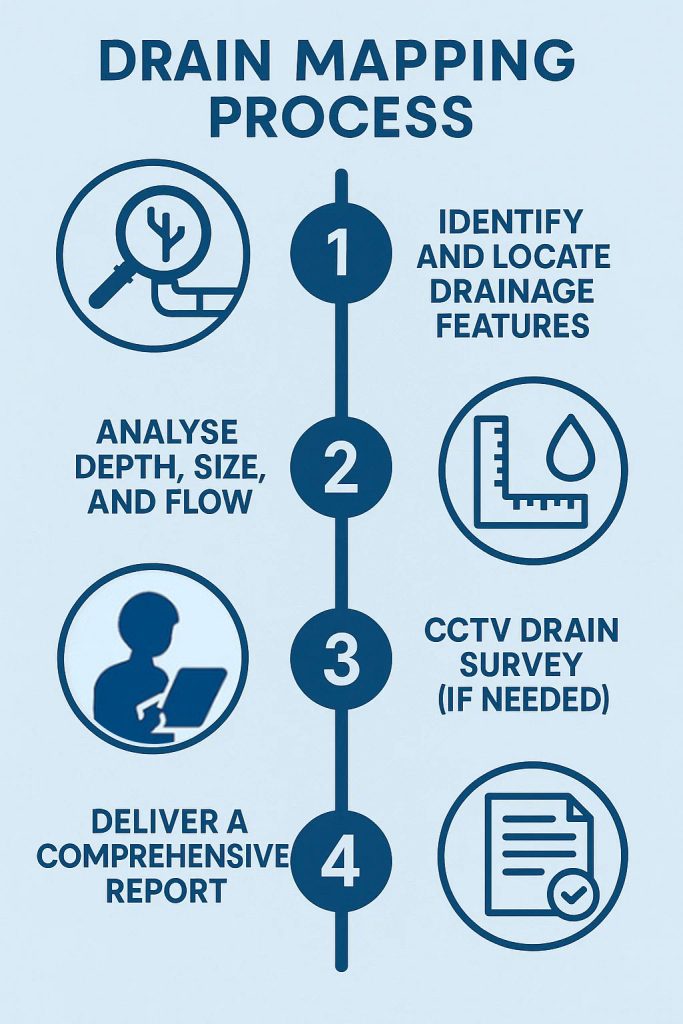Ever wondered what’s happening beneath your feet? If you’ve experienced drainage issues or are planning a construction project, understanding your underground drainage system is vital. That’s where drain mapping comes in.
With expert drain mapping surveys, you can get a complete understanding of your entire drainage network, avoid costly mistakes, and ensure compliance with environmental regulations.
This blog explains what drain mapping is, why it’s essential, how it works, and how a professional team can help. By the time you’ve finished reading, you’ll be fully equipped to make informed decisions about your drainage system.
What is drain mapping?

Drain mapping, also known as drain and asset mapping, is the process of visually and electronically identifying the layout and features of a drainage system. This includes pinpointing key components like pipes, manholes, gullies, and flow direction.
Using advanced tools such as GPS and plotting systems, drainage specialists create a detailed map of underground utilities. The map includes:
- Size of drain pipes to identify capacity.
- Depth and layout to understand how the system is structured.
- Water flow direction to determine how water or waste moves within the network.
This is not just a service to help you “know where things are.” Drain mapping lays the groundwork to prevent future problems, ensure smooth operations, and inform critical decisions for building projects or maintenance.
Why is a drain mapping survey important?
When it comes to keeping your property safe and functioning efficiently, having an accurate drainage map is essential. Here’s why:
For building projects
If you’re about to start a building project, detailed knowledge of your drainage system is vital for construction workers. Many times, securing planning permission requires a drain mapping survey. Without it, you might accidentally disrupt existing infrastructure, causing delays and unnecessary expenses. Knowing exactly where pipes and other drainage features are prevents costly mistakes during construction.
For flood risk management
One of the most critical applications of drain mapping is flood risk management. Inefficient or unknown drainage layouts can lead to disastrous flooding. A precise map helps you prepare better, ensuring effective drainage channels during heavy rainfall and reducing the risk of water damage.
For preventing damage
Blocked pipes, cracks, and other drainage issues can escalate quickly if left unchecked. A drain map helps you monitor the condition of your system, making it easy to spot potential weak points before they lead to damage.
For environmental compliance
Businesses that handle chemicals, trade effluents, or hazardous materials have a legal obligation to know where wastewater discharges. By investing in a drain mapping survey, you can remain compliant with environmental regulations while protecting water supplies from contamination.
The drain mapping process
Drain mapping is a multi-step process.
Here’s how it generally works:


Step 1: Identify and locate drainage features
Using GPS technology with accuracy up to 2cm, the team maps visible and underground drainage components and drainage infrastructure. Key features such as manholes, pipes, inspection chambers and gullies are identified and plotted precisely.
Step 2: Analyse depth, size, and flow
State-of-the-art tools allow engineers to measure pipe dimensions, depths, and the directional flow of wastewater or surface water. This information is crucial for everything from construction planning to emergency response strategies.
Step 3: CCTV drain survey (if needed)
To further inspect inaccessible areas, a CCTV drain survey may be conducted. This visual inspection allows the experts to assess the condition of pipes, check for the exact location of any blockages, and identify potential issues within the system.
Step 4: Deliver a comprehensive report
Once the survey is complete, a detailed report will be provided that includes:
- A full-scale drainage map.
- Accurate information on pipe conditions.
- Recommendations for repairs, maintenance, or upgrades if necessary.
More than just a survey
Drain mapping isn’t just about having a document to file away. Regular mapping as part of ongoing drain maintenance ensures your system stays in top condition and reduces risks of costly breakdowns.
FAQ
How much do drain mapping services cost?
The cost of drain mapping services can vary depending on the size and complexity of the drainage system. Smaller systems may cost less, typically starting from around £250, while larger or more intricate systems can range upwards of £1,000 due to the additional time and resources required. It is best to request a quote to get an accurate estimate tailored to your specific needs.
Is drain mapping carried out on the day or does it take longer?
Drain mapping can often be completed on the same day for straightforward systems, but more complex networks may require additional time. The duration depends on factors such as the system’s size, accessibility, and any unforeseen challenges encountered during the survey.
Is drainage mapping a legal requirement for construction work?
Yes, drainage mapping is often a legal requirement for building work to ensure compliance with local building regulations and environmental standards. It is essential for planning and preventing potential issues with existing drainage systems during and after construction projects. Always check local regulations to confirm your obligations.
Get in touch with BDS Drainage today!
If you’re experiencing drainage issues, don’t wait until they escalate into bigger problems. At BDS Drainage, we specialise in providing reliable and expert solutions tailored to your needs.
Our skilled team is here to ensure your drainage system operates smoothly and efficiently. Contact us today to discuss your concerns and see how we can help you maintain a trouble-free system.
Reach out to a local engineer now and take the first step toward peace of mind.

